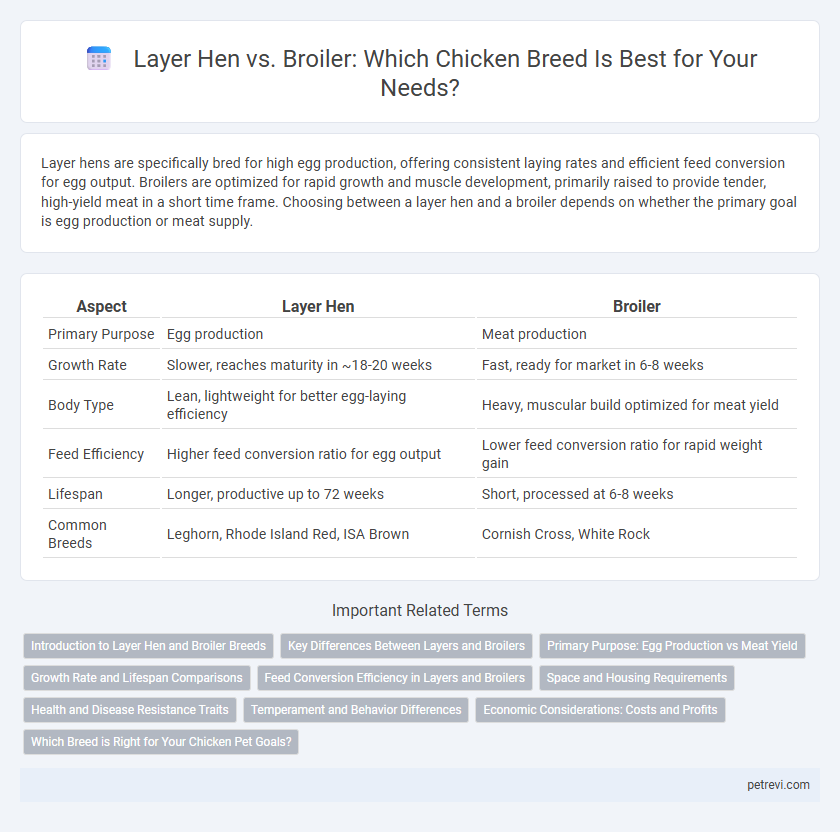Layer hens are specifically bred for high egg production, offering consistent laying rates and efficient feed conversion for egg output. Broilers are optimized for rapid growth and muscle development, primarily raised to provide tender, high-yield meat in a short time frame. Choosing between a layer hen and a broiler depends on whether the primary goal is egg production or meat supply.
Table of Comparison
| Aspect | Layer Hen | Broiler |
|---|---|---|
| Primary Purpose | Egg production | Meat production |
| Growth Rate | Slower, reaches maturity in ~18-20 weeks | Fast, ready for market in 6-8 weeks |
| Body Type | Lean, lightweight for better egg-laying efficiency | Heavy, muscular build optimized for meat yield |
| Feed Efficiency | Higher feed conversion ratio for egg output | Lower feed conversion ratio for rapid weight gain |
| Lifespan | Longer, productive up to 72 weeks | Short, processed at 6-8 weeks |
| Common Breeds | Leghorn, Rhode Island Red, ISA Brown | Cornish Cross, White Rock |
Introduction to Layer Hen and Broiler Breeds
Layer hens are specifically bred for high egg production, with breeds like Leghorn and Rhode Island Red known for their prolific laying abilities and efficient feed conversion. Broiler chickens, such as Cornish Cross and Cobb 500, are optimized for rapid growth and meat yield, reaching market weight significantly faster than layer breeds. Understanding these distinct breed purposes helps optimize poultry farming operations for either egg or meat production.
Key Differences Between Layers and Broilers
Layer hens are bred primarily for high egg production, characterized by efficient feed-to-egg conversion and a leaner body structure. Broilers are specifically raised for meat, exhibiting rapid growth rates and a stockier build with higher muscle mass. Key differences include growth rate, body composition, and primary output: eggs versus meat.
Primary Purpose: Egg Production vs Meat Yield
Layer hens, specifically bred for high egg production, exhibit traits such as efficient feed conversion to support consistent laying cycles, often exceeding 300 eggs per year. Broilers are genetically optimized for rapid growth and high meat yield, reaching market weight in as little as six to eight weeks with increased muscle mass. Selecting between layer hens and broilers depends on the primary production goal: maximizing egg output or optimizing meat quantity and quality.
Growth Rate and Lifespan Comparisons
Layer hens are bred primarily for egg production, exhibiting a slower growth rate and longer lifespan of up to 72 weeks or more to maximize egg-laying capacity. Broilers, optimized for meat production, grow rapidly, reaching market weight in just 6 to 8 weeks but have a significantly shorter lifespan due to intensive growth demands. The distinct breeding goals result in layer hens prioritizing endurance and sustained productivity, while broilers emphasize fast growth and feed efficiency.
Feed Conversion Efficiency in Layers and Broilers
Layer hens exhibit a feed conversion efficiency (FCE) optimized for egg production, converting approximately 2 to 2.5 kilograms of feed per kilogram of eggs produced. Broilers demonstrate a significantly higher growth rate with an FCE ranging from 1.5 to 1.7 kilograms of feed per kilogram of body weight gain, emphasizing meat yield efficiency. The distinct metabolic focuses of layers and broilers underscore their specialized breeding goals for optimal productivity in egg versus meat production.
Space and Housing Requirements
Layer hens require less space per bird, typically around 1.5 to 2 square feet, as their housing prioritizes nesting and roosting areas to support egg production. Broilers need more spacious environments, approximately 2.5 to 3 square feet per bird, to accommodate rapid growth and reduce stress from overcrowding. Effective ventilation and clean bedding in broiler housing are essential for maintaining health and optimizing meat yield.
Health and Disease Resistance Traits
Layer hens are selectively bred for high egg production, exhibiting strong immune responses that reduce susceptibility to common poultry diseases like Marek's disease and coccidiosis. Broilers, developed for rapid growth and meat yield, often have compromised disease resistance, making them more vulnerable to conditions such as bacterial infections and metabolic disorders. Genetic lines with enhanced health traits improve overall flock resilience, supporting sustainable poultry farming practices.
Temperament and Behavior Differences
Layer hens exhibit calmer temperaments and more stable social behaviors suited for consistent egg production, while broilers display faster growth rates paired with more sedentary and less social tendencies due to selective breeding for meat yield. Layer breeds often engage in more active foraging and maintain better mobility, whereas broilers may show increased susceptibility to stress and aggression from limited movement. These behavioral distinctions influence management practices, welfare standards, and housing designs tailored to each breed's production purpose.
Economic Considerations: Costs and Profits
Layer hens are optimized for egg production, offering steady income with lower feed costs per egg compared to broilers, which require higher feed inputs but yield meat rapidly. Broilers provide quicker returns due to their fast growth rate and higher meat yield, but feed expenses and market price volatility can significantly affect profit margins. Economic decisions between breeds depend on balancing feed efficiency, output value, and consumer demand in poultry production.
Which Breed is Right for Your Chicken Pet Goals?
Layer hens are bred primarily for egg production, offering high yields of large, consistent eggs ideal for pet owners focused on fresh, homegrown eggs. Broilers, on the other hand, are optimized for rapid growth and meat production, making them suitable for those raising chickens for consumption rather than egg-laying purposes. Choosing the right breed depends on whether your chicken pet goals prioritize egg quantity and quality or meat yield and growth speed.
Layer Hen vs Broiler for Chicken Breed Purpose Infographic

 petrevi.com
petrevi.com